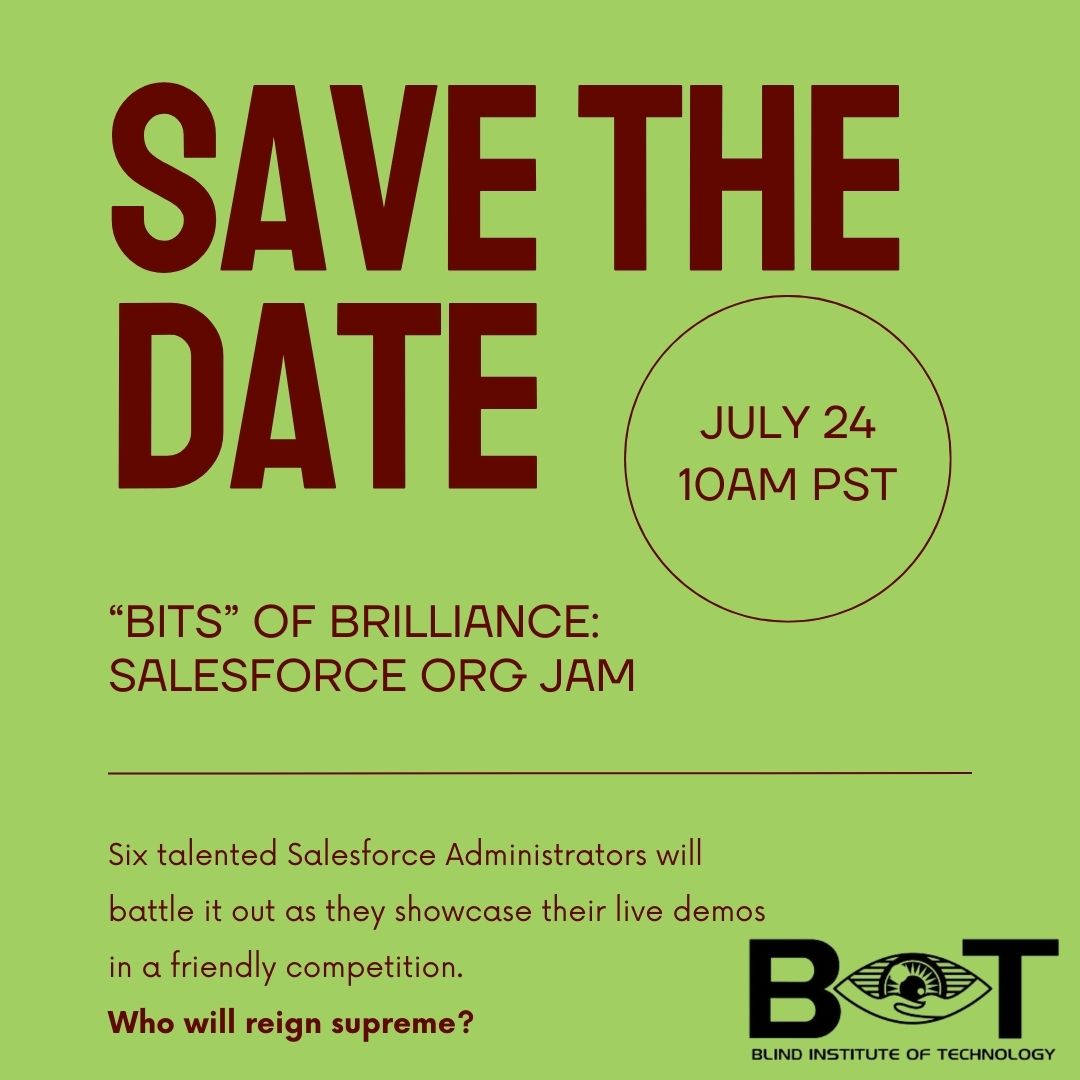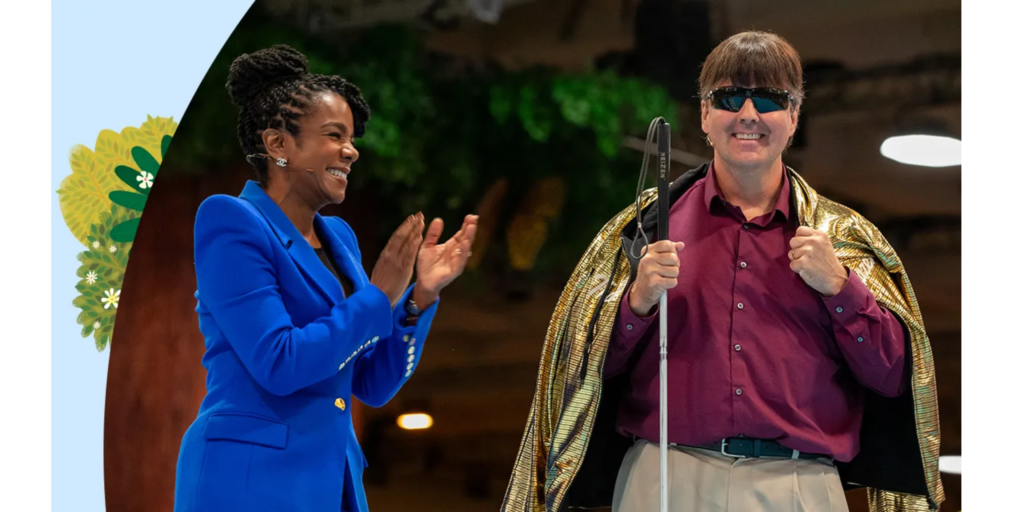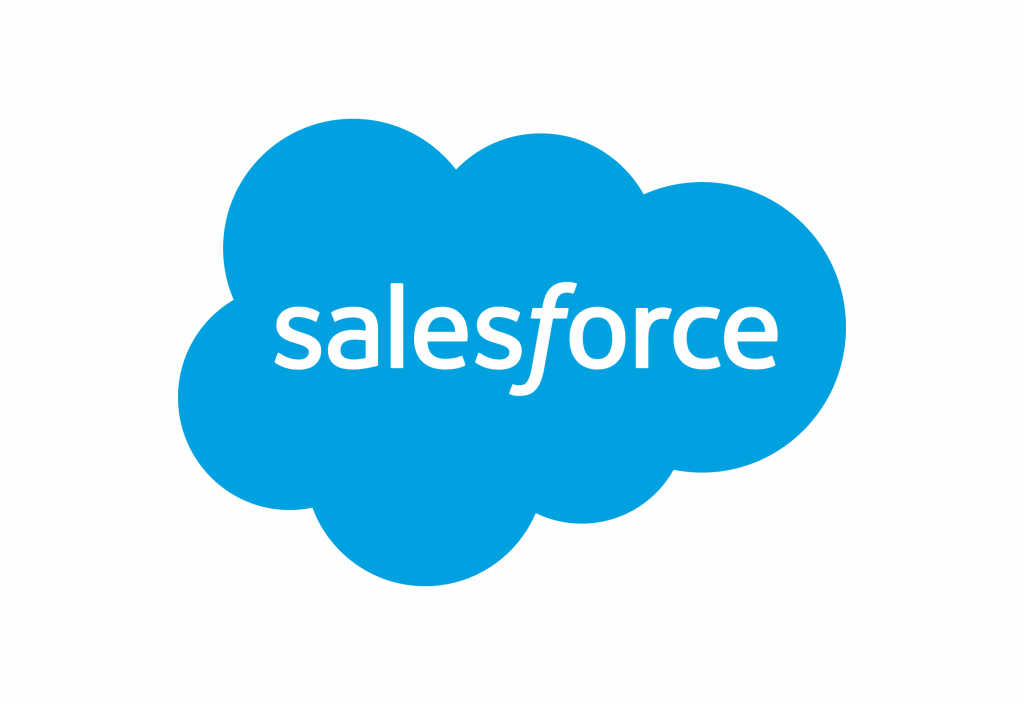Applications for the fall 2024 Digital Accessibility Analyst course will be opening soon! Stay tuned for important news and updates including close date, open houses, deadlines, and start dates!
Fall Digital Accessibility Analyst Course


Applications for the fall 2024 Digital Accessibility Analyst course will be opening soon! Stay tuned for important news and updates including close date, open houses, deadlines, and start dates!

Image Description:
This green BIT save the date webinar graphic has the BIT logo in the bottom right-hand corner, the date of July 24, 10AM PST circled and the following text: “BITS” of Brilliance: Salesforce Org Jam. Six talented Salesforce Administrators will battle it out as they showcase their live demos in a friendly competition. Who will reign supreme?
Hold onto your hats because the BIT Academy has been on fire this past month! We are currently cruising into week 7 of our third cohort in the Digital Accessibility Analyst Program. Who knows what surprises and discoveries await us in the weeks to come?
Our students continue to blow us away with their dedication and talent. Just when we thought they couldn’t get any more amazing, we had yet another student from the second cohort pass their Certified Professional in Accessibility Core Competencies (CPACC) exam! Huge congratulations to Katya Chupryna on this incredible achievement!
And that’s not all! Get ready to mark your calendars because we are on the brink of unveiling a new BIT Academy website! This versatile platform will showcase all of our fantastic courses, student portfolios, industry-specific resources and tools, and even publications from our brilliant students and staff.
There’s more excitement in store! The Academy has placed four candidates with one of the largest communication technology companies on the planet for an exciting year-long contract conducting accessibility analysis. Talk about making waves in the industry!
Stay tuned because the adventure at the BIT Academy is just getting started!
The language we use to talk about accessibility is very different from the language most developers and designers use when designing websites, building websites, or building applications. This language barrier is closely related to why accessibility is often missing from most development lifecycles.
This document is designed to help translate accessibility barriers and challenges into language that developers and designers can understand. If we can present accessibility issues in ways that can be understood, that means the appropriate actions can be taken to resolve and eliminate them.
We will start by breaking down some of the technology including the Document Object Model and the Accessibility Tree. Then we will dive into the assistive technology side of things and how we can explore the back end (code) behind the website or app. We will wrap things up by going over some of the most common accessibility issues, how to report accessibility issues using common language, and where our feedback should be sent to ensure it reaches the right person.
Following this guide will help drive the change towards a more accessible, equitable, and inclusive online experience for everyone, regardless of the technology, user settings, or assistive technology in use.
We are excited to announce the first Digital Accessibility Analyst course of 2024 will begin the week of February 15. Applications will be sent to BIT Career-Seekers only on January 19 with a deadline of January 26.
All your questions about the course can be answered at one of our open houses. They will be held:
*times are in US Mountain time:
Video call link:
Video call link: https://meet.google.com/qbq-djpa-fyb
Or dial: (US) +1 929-287-3337 PIN: 868 378 064#
View the slide deck from the open house.
Watch the playback from our January 10, 2024 open house
Read the transcript from our January 10, 2024 open house
Video call link: https://meet.google.com/xut-svfk-kad
Or dial: (US) +1 781-667-0102 PIN: 127 721 207#
If you have additional questions, please direct them to Academy@BlindIT.org
We are excited to announce the first Salesforce Admin course of 2024 will begin the week of January 16. Applications will be sent to BIT Career-Seekers only on December 15 with a deadline of December 22. Prerequisites are required for this course. Additional Information and course prerequisites can be found here
All your questions about the course can be answered at one of our open houses. They will be held:
*times are in US Mountain time:
Video call link:
https://meet.google.com/qoz-dyfb-gtk
Or dial: (US) +1 815-916-5960 PIN: 876 590 708#
Watch the playback from our December 6, 2023 Open House
Read the transcript from our December 6, 2023 Open House
Video call link:
https://meet.google.com/wbc-eesw-pnj
Or dial: (US) +1 786-619-1536 PIN: 183 689 523#
If you have additional questions, please direct them to Academy@BlindIT.org

As we approach the season of giving, there’s no better way to kickstart the festivities than by participating in Colorado Gives Day 2023. This annual event has become a beacon for countless organizations, uniting communities to make a positive impact.
Colorado Gives Day is a force for change empowering individuals, families, and businesses to come together in support of the incredible nonprofits that tirelessly serve our communities. Through this event, every dollar donated goes even further. Generous sponsors provide a boost to each contribution, amplifying the impact of your donation. This means your support has a ripple effect, touching more lives and creating a broader positive influence.
You can find our page here. Even if you’re unable to donate, spreading the word helps make just as much of an impact. Join us for early giving starting November 1, which ends with Colorado Gives Day on December 5. Together, we can light up Colorado with compassion, kindness, and a shared commitment to a better future.

People who are blind or visually impaired face barriers to employment, including challenges with transportation and lack of accessibility in the workplace. Mike Hess, Founder and Executive Director of the Blind Institute of Technology, joins host Tetiana Anderson to discuss a workforce development solution for people who are blind or visually impaired.

Mike Hess was born blind and faced many challenges growing up. He struggled with the stigma of being blind and the lack of accessible resources. Despite these challenges, he built a successful career in the tech sector.
However, Hess always felt like the “token blind guy” and wanted to do more to help others with disabilities. In 2013, he founded the Blind Institute of Technology (BIT) to reduce the unemployment rate for the blind and visually impaired community.
BIT provides accessible technology training and partners with companies like Salesforce to create more employment opportunities for people with disabilities.
In conclusion, Mike Hess is a passionate advocate for people with disabilities. He is using his own experiences to help others overcome the challenges they face and achieve their full potential.


Salesforce Proudly Presents a Gala Fundraiser for the
Saturday, October 14, 2023, 5:30PM – 10PM
Salesforce proudly presents the Blind Institute of Technology’s Dining In The Dark Fundraising Gala at the Kimpton Hotel Monaco in Philadelphia, Pennsylvania. BIT is a 501(c)(3) nonprofit organization providing workplace development and inclusive employment solutions for individuals with disabilities. BIT helps ready individuals with disabilities for success in the workplace as well as aids the employers who hire them!
Blind Institute of Technology is excited to bring its Dining In The Dark Annual Fundraiser to Philadelphia to help significantly reduce the severe unemployment and underemployment rates of people with disabilities on both a local and national level. Please join us at the Kimpton Hotel Monaco to learn more about The Greatest Equalizer and for a night of fun!
Why partner? Join other corporate partners and sponsors to make a positive impact on current and future young professionals that have a visual impairment or other disability by assisting them in gaining the skills they need for meaningful work with a living wage.
The facts speak for themselves and this is why we do what we do every day. Our team recruits candidates with disabilities from universities, vocational rehabilitation centers, disability-focused forums and events, and social media. Our career development services include interactive workshops, resume writing, interview training, and specific skill training. Our BIT Academy focuses on official certifications for careers at companies such as Salesforce, Cisco, Amazon, and companies within their ecosystems. At a minimum, we guarantee each candidate who completes a course from the BIT Academy a paid internship with the ultimate goal of placement in a full-time employment role. Candidates we place earn a median salary of $72,000.00 per year which is 40% higher than the U.S. average household income of $50,740 per year. At the same time, we work closely with our corporate partners to increase awareness and education on the value of hiring individuals with disabilities.
BIT’s services are 100% complimentary to all of our candidates. Even after we place our candidates in meaningful careers we continue to mentor and provide career guidance to them. Upon successful completion of the BIT Academy courses, we work closely with the candidate and our corporate partners to identify the perfect fit for mutual success on both the candidate and corporate sides. On average we invest about $5,400 in each candidate that completes our BIT Academy courses. For 2022, our goal is to have at least 100 candidates complete the BIT Academy’s skill-up courses to then place them on a life-changing meaningful career path.
All the money raised at the Dining In The Dark Gala will go directly to maximizing the number of candidates that participate in the BIT Academy and Apprenticeship Program. Please help us achieve our goal by joining us at the Dining in the Dark Gala as a partner in our mission. There will be a seated dinner, live auction, and entertainment.
Blind Institute of Technology is a 501(c)3 nonprofit organization. TAX ID 46-2557719
We must receive your sponsor commitment, logo, and payment no later than 9/21/23 for inclusion in Gala program.
Please contact Natalie to secure your sponsorship, make payments and give guest information. She can be reached at natalie@blindit.org or 303-995-1006